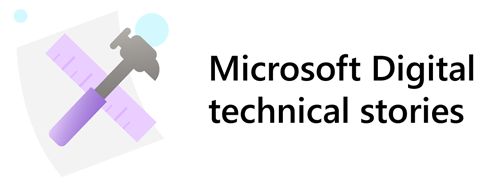
When our employees look for content internally here at Microsoft, they go to Microsoft 365 Copilot Chat first. With Copilot Chat, they can easily get answers to questions, catch up on missed work, generate new ideas, and more by tapping into the work data that they have access to via Microsoft Graph.
An employee might ask, “Can you tell me how I can learn more about AI in Healthcare and who the experts are in the company?”
Whether they ask in Microsoft Teams or another Microsoft 365 app, or right in their browser, they likely will get a helpful, accurate response very specific to the healthcare sector. The answer could refer to an AI industry PowerPoint presentation, articles on responsible AI strategies, Microsoft Research publications, or a list of employees who are experts on the topic.
But how does Copilot know how to reference the AI industry PowerPoint presentation for Healthcare? How does it know which versions of the responsible AI strategies for Healthcare articles to use? How does it identify experts in the company?
It’s because Copilot connects to all the content on the topic available through Microsoft Graph.
“Our internal Microsoft content is the content Copilot uses to generate its results,” says Dodd Willingham, a principal program manager and internal search administrator in Microsoft Digital, the IT organization at Microsoft. “How Copilot consumes and uses our content determines the success—or failure—of Copilot for our employees.”
{Learn how AI is already changing work—including here at Microsoft. Check out how we’re reimagining content management at Microsoft with SharePoint Premium.}
Enabling useful results

When it comes to returning the right content with Copilot, context is key.
Copilot uses the capabilities of Microsoft Graph to power its AI-generated results. For Microsoft Digital—like most organizations—that includes the content our users store and work with in our Microsoft 365 tenant. Results from Copilot directly depend on the quality of the content it uses. There’s an enormous opportunity to increase the capabilities of Copilot-based solutions because the underlying content is of such high quality. We’re seizing that opportunity to get this right internally at Microsoft.
“You hear a lot of people talking about Copilot, but few address the importance of improving content quality,” says Stan Liu, a senior product manager and knowledge management lead with Microsoft Digital. “The quality of an organization’s content management must be considered in every implementation of Copilot, and we’re doing some great things at Microsoft Digital to ensure Copilot returns accurate, relevant, and up-to-date responses.”
It’s an exciting time to be in content management, and we’re excited to share how our team in Microsoft Digital has met and addressed the challenges of preparing our content for a bright future with Microsoft 365 Copilot.
Curating enterprise content for Microsoft 365 Copilot
There’s an urgency for organizations to bring advanced AI tools to their employees, but it must be done thoughtfully and with good intentions. One of the fundamental challenges in implementing generative AI technologies like Copilot is balancing the desire to move quickly with the need for caution with technology possessing potential risks that haven’t been fully revealed.

“A lot of what we do lies in managing our content in a way that aligns with company strategy, and Copilot isn’t different in that respect,” says David Johnson, a tenant and compliance architect in Microsoft Digital who ensures that the company’s content is well governed. “It’s important that Microsoft employees understand why content management is important and how they can help do it well.”
To be effective, we must lean into our ongoing culture shift to embrace knowledge sharing. We’ve been fostering a knowledge-sharing culture at Microsoft for years, and our adoption of Copilot has magnified the importance of that culture and the need to continue driving awareness and education for Microsoft employees.
Liu and his team are prioritizing this culture transformation.
“You need to build and encourage a culture that embraces user-driven content management,” Liu says. “Teams that document their knowledge, follow a content lifecycle in their workflows, and manage content consistently across the company are contributing hugely to what we’re trying to accomplish.”
It’s a two-fold challenge that involves encouraging and supporting our employees in collaboration and sharing and ensuring that the tools they use—including Copilot—provide results they can trust and use confidently.
“We’ve set goals within our organization to make Copilot a daily habit,” Liu says. “Community engagement and participation is a significant part of Copilot adoption, and we’ve been identifying use cases and success stories across Microsoft to share as success stories to inspire our employees and encourage adoption and innovation.”
Next generation content management with SharePoint Premium
Microsoft SharePoint Premium (formerly known as Syntex) is a critical part of our content management strategy to get the most out of Copilot. We’re using the AI capabilities in SharePoint Premium to give employees access to simple and capable content management tools.
SharePoint Premium helps our Microsoft Digital enterprise content team ensure the right capabilities are in place to help people manage content. Missing metadata is a common issue with information stored in SharePoint, and SharePoint Premium makes it easier for users and administrators to add metadata, classify and organize content.
SharePoint Premium brings AI, automation, and added security to our content experiences, processing, and governance. SharePoint Premium delivers new ways to engage with our most critical content and prepare it for Copilot, helping us manage and protect it throughout its lifecycle.
Automating metadata extraction with document processing
The document processing capabilities in SharePoint Premium simplify and automate the process of extracting important information from existing content. Liu’s team helped deploy the document processing capabilities across Microsoft to enable teams to automate processing of important content, such as contracts, invoices, and statements of work.
Document processing uses machine learning models to recognize documents and the structured information within them. Using optical character recognition (OCR) combined with deep learning models, it identifies and extracts predefined text and data fields common to specific document types, including contracts, invoices, and receipts. It also supports the detection and extraction of sensitive data such as personal and financial identification. Liu’s team is using prebuilt and custom document processing models to automatically populate metadata columns in SharePoint for many different document types. The metadata this processing provides improves search and creates a more complete understanding of what the files contain, so Copilot can recognize and return relevant information that was previously incomplete or unavailable.
“We’re capturing information across a plethora of documents automatically and almost none of it was recorded previously,” Liu says. “Some of our business groups were entering the metadata manually, but it was a time-consuming and expensive process. For most documents, it just wasn’t done. It’s a massive difference-maker in finding information about a specific contract or invoice that would have been close to impossible. Now with SharePoint Premium and Copilot, it’s a simple question away.”
Standardizing content creation with content assembly
Liu’s team enabled the content assembly feature of SharePoint Premium across the company to simplify document creation and ensure that new documents follow metadata and structure guidelines.
Content assembly creates modern templates that can be easily maintained and used to generate repetitive documents quickly. This feature is particularly useful for departments like finance, where templates for partner letters or contracts are frequently needed. By using content assembly, teams can reduce the time spent on template management and document generation, as it allows for the creation of documents with just the key parts needing changes.
While the time-saving benefits of content assembly don’t directly affect Copilot results, they do encourage users to create better documents, eliminating the need to rewrite entire documents or repeatedly upload the same document. These documents—created using modern templates—are significantly more discoverable and classifiable and lead to more authoritative answers in Copilot.
Taxonomy tagging
Liu oversees a team that has been managing the company’s corporate taxonomy in the SharePoint term store for many years, maintaining a hierarchy of terms that can be reused throughout the SharePoint environment. The term store helps ensure that SharePoint metadata is consistent across the organization, and it provides employees with a standard set of choices when populating commonly used metadata such as products, job roles, or departments.
Taxonomy tagging in SharePoint Premium automatically tags documents in SharePoint libraries with terms configured in the term store using AI. As at other companies, we face the ongoing challenge of getting employees to tag content. Most times, even when you have managed metadata set up in your document library, employees often don’t use it. This means the content is never further enriched with that metadata.
With taxonomy tagging, you set it and forget it. Uploaded content is automatically tagged, which does the job that a person would typically do, but often never does. This automated process ensures that documents get one or more metadata columns populated with standard terms from the term store based on the document content. This leads to more complete metadata for documents and more authoritative results for Copilot results when referencing data in those documents.
Using generative AI to help generative AI with autofill columns
Autofill columns in SharePoint Premium takes content management to the next level by harnessing AI LLMs to automatically extract, summarize, and generate content from files uploaded to your SharePoint document library. This feature allows users to set up a simple natural language prompt on a column in SharePoint that extracts specific information or generates content from files. The extracted information is then displayed in the columns of the library, making it easier to manage and analyze data.
Liu has a lot to say about how his team is transforming document processing with autofill columns in SharePoint Premium, “autofill columns are a game-changer for enhancing productivity in Copilot and ensuring that our documents have the necessary context for efficient retrieval and use. Autofill’s impact on our metadata within SharePoint document libraries is huge.”
Teams within Microsoft have started setting up new and existing columns with prompts to identify the types of information to extract from a file. These prompts can be customized and tested to ensure that they provide the desired results. After the autofill columns are set up, any new files uploaded to the library are automatically processed (and existing documents can be manually processed), and the result of the prompt is saved to the corresponding columns.
This approach not only streamlines document processing workflows but also enhances the overall efficiency and accuracy of their data management practices, making Copilot even more powerful and effective.
Continuing to grow with SharePoint Premium
Liu’s team continues to drive SharePoint Premium as a crucial part of their content management toolkit. “We’re seeing immediate and significant benefits from using SharePoint Premium and its AI features to manage our content,” Liu says. “In the first half of 2024, we estimated that our employees saved more than 120,000 hours in processing documents, pages, and images across the company for over 1,000,000 content items in our environment. It’s a great start, and we’re targeting even greater improvements across more content soon.”
Protecting content with Microsoft Purview Information Protection
Microsoft Purview Information Protection provides a wide range of content governance capabilities that help us discover, classify, and protect sensitive information wherever it stays or moves in the Microsoft tenant.
We use Purview Information Protection tools to identify sensitive content using expressions, functions, and trainable classifiers. With these tools, our enterprise data teams and employees can use corroborative evidence like keywords, confidence levels, and proximity to identify sensitive information types. They can also use examples of sensitive content to train recognition engines on expected patterns. All of this helps to better inform Copilot regarding the relevance of our Microsoft 365 content.
We use sensitivity labels in Purview to apply flexible protection actions that include encryption, access restrictions, and visual markings. This capability ties in nicely with SharePoint Premium, which also uses and applies sensitivity labels.
Purview sensitivity labels provide a single labeling solution across apps, services, and devices to protect content as it travels inside and outside our organization. Purview sensitivity labels can be applied to Microsoft Office documents, third-party document types, meetings, chats, and the broader Microsoft 365 environment.
The sensitivity labels that we use to protect our content are recognized and used by Copilot to provide an extra layer of protection. For example, in Copilot Chat conversations, which can reference content from different types of items, the sensitivity label with the highest priority (typically, the most restrictive label) is visible to users. If the labels apply encryption from Microsoft Purview Information Protection, Copilot checks the usage rights for the user and only returns content that the user has access rights to.
Looking forward
Our enterprise content management transformation is ongoing.
Our teams are looking at new content management capabilities across the company to ensure Copilot continues to provide current, accurate, and relevant results for our employees.
We’re continually evaluating our enterprise content management to identify new ways to create a Copilot-assisted workday for Microsoft employees. We’re also evaluating new technology, organizational practices, and industry standards as we strive to set the standard for how an organization can capture maximum value from its content using Copilot.
We’re currently working with the SharePoint Premium product team to grow the AI-based capabilities for content management and classification. We’re experimenting with our own solutions and capabilities in SharePoint that will lead to the next generation of AI-supporting features that drive innovation and creativity here at Microsoft and for our customers.

Are you looking to prepare your enterprise content for Copilot and AI? Here are a few suggestions:
- Pursue content quality. Ensure that the content is current, accurate, and relevant. This is crucial for Copilot to provide authoritative answers and maintain user trust.
- Promote knowledge sharing. Foster a culture of knowledge sharing within the organization. Encourage teams to document their knowledge, follow a content lifecycle in their workflows, and manage content consistently across the company.
- Use SharePoint Premium. Use the AI capabilities in SharePoint Premium to simplify and automate content management processes.
- Implement Purview Information Protection Use Purview Information Protection tools to apply sensitivity labels to ensure content is protected as it travels inside and outside the organization.
- Prepare for future enhancements. Stay updated with ongoing transformations in enterprise content management and Copilot capabilities.

- Learn how AI is already changing work—including here at Microsoft.
- Here’s how you can get started with Microsoft SharePoint Premium.
- Learn more about Microsoft Purview.
- Check out how we’re reimagining content management at Microsoft with SharePoint Premium.
- Discover getting to ‘search completeness’ internally at Microsoft.
- Find information faster: How Microsoft is transforming internal search.
- Explore how Microsoft redefines the digitally assisted workday.
- Unpack internal search bookmarks and how it boosts productivity at Microsoft.






